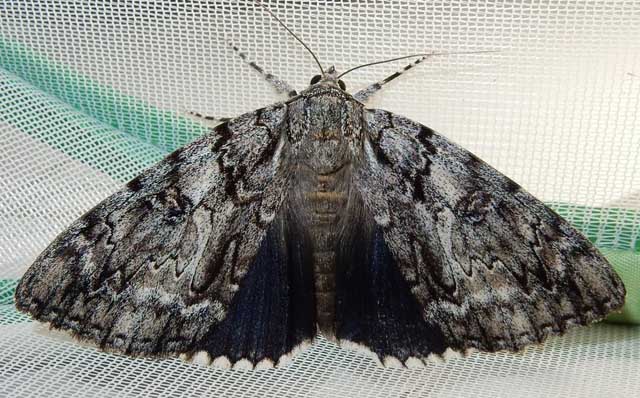Catocala ulalume
Catocala ulalume
kah-TOCK-uh-lah M
EWE-lah-loom
Strecker, 1878

Catocala ulalume Louisiana, courtesy of Vernon A. Brou.

Catocala ulalume, Hurlock, Dorchester County, Maryland,
August 4, 2019, courtesy of Jonathan Willey, id confirmed by Larry Gall.
This site has been created by Bill Oehlke.
Comments, suggestions and/or additional information are welcomed by Bill.
| TAXONOMY:
Superfamily: Noctuoidea
Family: Erebidae, Leach, [1815]
Subfamily: Erebinae, Leach, [1815]
Tribe: Catocalini, Boisduval, [1828]
Genus: Catocala, Schrank, 1802
|
DISTRIBUTION:
The Ulalume Underwing, Catocala ulalume
(wingspan: 60-75mm), flies from Virginia, through Georgia, to
Florida,
west to Texas and eastern Oklahoma and north to
Illinois
and Michigan.
It is also confirmed in
Alabama,
Arkansas,
Delaware (LG),
Indiana (SM),
Kansas,
Kentucky,
Louisiana,
Maryland (JW),
Mississippi,
Missouri,
New Jersey (LG),
North Carolina,
Ohio,
Pennsylvania,
South Carolina and
Tennessee.
I expect it is also in Indiana, but I have no confirmed reports of it in Indiana. Scott Mescher
has confirmed it for eastern Indiana, Jay County.
The forewing colouration is a mottled light to dark grey with no strongly contrasting lines,
dashes or bars. At the inner margin the antemedial line ends with in a very light coloured
crescent very close to the pm line. The open subrenifrom spot is also light coloured and "comma" shaped with a somewhat triangular and
somewhat bulbous head.
The am line has a short, thin, slightly humped dark line through its midpoint.
The hindwing is black and the fringe is pure white with thin, sharp (pointed)
checking. Catocala ulalume, 65mm, courtesy of Jim Vargo. |  |

Catocala ulalume, Hurlock, Dorchester County, Maryland,
August 4, 2019, courtesy of Jonathan Willey, id confirmed by Larry Gall.
Larry Gall recently confirmed Jonathan Willey's determination of the above moth. I asked Dr. Gall how he distinguishes between ulaluma and similar species and
he wrote back, "The species it gets confused with all the time is lacrymosa -- not retecta, dejecta or luctuosa which are all quite different. Itís ulaume and
not lacrymosa based on the steely blue ground color, PM line, lack of brownish irroration, etc. I didnít have a record for MD yet, although I did for nearby
in DE, PA, and NJ, so it is not surprising but excellent nonetheless! Best, Larry"

Catocala ulalume, lights, Woodlawn, Montgomery County, Tennessee,
July 18, 2008, courtesy of Tom Payne, id by Bill Oehlke.
Strecker probably chose the species name from the Edgar Alan Poe
poem, "Ulalume":
".............
But were stopped by the door of a tomb--
By the door of a legended tomb;
And I said:"What is written, sweet sister,
On the door of this legended tomb?"
She replied:"Ulalume--Ulalume--
'Tis the vault of thy lost Ulalume!"
.............."
I have not Latinized the final "e" in
ulalume as the name (rhymes with tomb) is taken directly from the poem.
FLIGHT TIMES AND PREFERRED FOOD PLANTS:
Catocala
ulalume flies as a single
generation with moths on the wing from June to September.
The Catocala ulalume caterpillar feeds on Carya alba and probably
other Carya species.
ECLOSION:
Adults eclose from pupae formed under leaf litter.
SCENTING AND MATING:
Catocala ulalume females
emit an airbourne pheromone and males use their antennae to track the
scent plume.
EGGS, CATERPILLARS, COCOONS, AND PUPAE:
Eggs are deposited on tree bark in the fall and hatch the following spring.
Mature larvae Image courtesy of |
 |
Larval Food Plants
Listed below are primary food plant(s) and alternate food plants.
It is hoped that this alphabetical listing followed by the common
name of the foodplant will prove useful. The list is not exhaustive,
although some species seem very host specific.
Experimenting with closely related foodplants is worthwhile.
Carya alba.......
|
Mockernut hickory/white hickory
|
Use your browser "Back button to return to the previous page.
Goto Main Catocala Index
This page is brought to you by Bill Oehlke and the
WLSS. Pages are on space rented from Bizland. If you would like to become a "Patron of the Sphingidae/Catocala Sites",
contact Bill.
Please send sightings/images to Bill. I will do my best to respond to requests for identification help.
Enjoy one of nature's wonderments: Live Saturniidae (Giant Silkmoth) cocoons.

|

To show appreciation for this site, click on the flashing
butterfly to the left, a link to many worldwide insect sites. |






